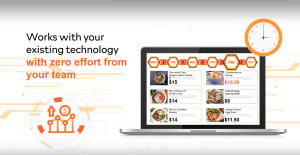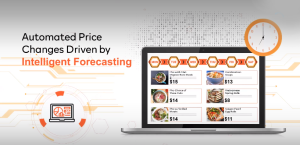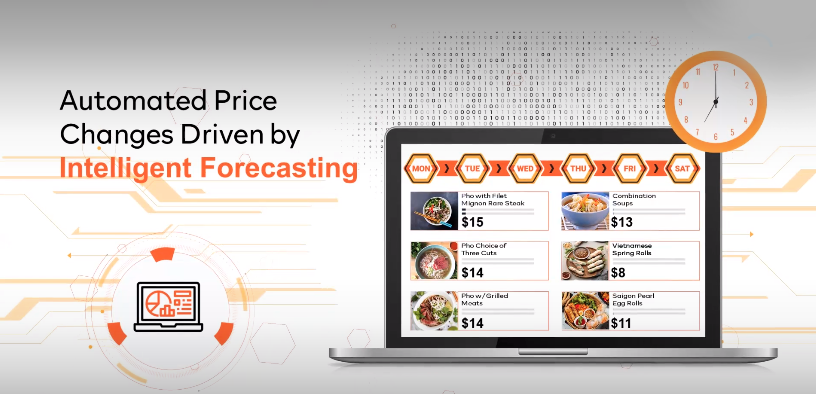Juicer is the latest company helping restaurants implement dynamic pricing and two of its co-founders, Ashwin Kamlani and Carl Orsbourn, believe this new pricing model is the key to improving off-premises profits and flattening out rush periods in this era of stretched labor.
After researching the industry throughout 2021, the San Francisco-based company officially incorporated at the start of this year with a goal of making big changes to restaurant operations and profitability through what the founders characterize as slight fluctuations in prices for delivery and takeout orders.

Juicer CEO Ashwin Kamlani
As CEO, Kamlani leans on his deep background in hospitality, which gave him a front-row seat to the post-9/11 era when aggregators like Expedia, Travelocity and Orbitz upended the airline and hotel industries. Those buzzy new third-party websites caused hotels to worry about a loss of control over their customers (and customer data), while growing the traveling population at large—if customers in exchange offered up a little bit of flexibility on timing.
Twenty years later, he’s confident the same conditions apply to restaurants as third-party aggregators like DoorDash and Uber Eats helped create more dining occasions at the expense of profitability. Juicer’s team believes a fluid pricing model specifically built for this situation could be the best thing that’s happened to restaurants since customers began stampeding toward delivery.
Kamlani explains that it’s not just ratcheting up the price of items and boosting profitability during peak periods that makes dynamic pricing such a revolution. In this era of incredibly scant labor resources, restaurants can also lower prices when business is slow to spur traffic and use pricing to shift cost-conscious customers to off-peak periods to maintain smooth operations in the kitchen.
“When we saw this happening in restaurants, all these alarm bells started going off, like, OK, wait a minute,” he said. “The limit on capacity in a restaurant is the number of seats you have in the house, but also the amount of output that can come out of the kitchen within a specific time period—so many of the same principles apply.”

Juicer COO Carl Orsbourn
Carl Orsbourn, co-author of Delivering the Digital Restaurant and Juicer’s chief operating officer, likens dynamic pricing to the rise of ghost kitchens. He spent a year as vice president of operations at Kitchen United and, before that, spent 18 years at global energy giant bp, helping the company manage gasoline prices across the U.K.
“This is another example of why [restaurants] should be excited about the digitization of our industry,” he said, “and why digital menus open up this whole new opportunity for revenue growth and, ultimately, margin growth in a channel that has been under pressure for a while due to low margins.”
A price for every occasion
After surviving the pandemic, Juicer feels this is the perfect moment for restaurants to change their pricing to bring in more revenue and ease their labor pressures. Because dynamic pricing is inherently complex, the two co-founders (of four) stress that restaurants need a sophisticated solution for adjusting prices, without hiring additional staff to make it happen.
“Pricing in the restaurant industry has been largely unscientific, and there’s so much data available to help make better decisions, but restaurants either don’t have access to the data or don’t know what to do with the data or don’t have people who would know what to do with the data,” Kamlani said. “That’s point number one: start to use all the data that’s available with a trusted partner to make better and smarter decisions.”
 Orsbourn and Kamlani outline a handful of scenarios where restaurants benefit from shifting prices up and down, depending on daily conditions ranging from ingredients on hand to nearby events and year-over-year sales data.
Orsbourn and Kamlani outline a handful of scenarios where restaurants benefit from shifting prices up and down, depending on daily conditions ranging from ingredients on hand to nearby events and year-over-year sales data.
“The low-hanging fruit here is to use all of that data to figure out, when things are busy, how can I make more money from that?” Kamlani said. “If I own a pizzeria and I’m on a college campus and have a line out the door at 1 AM because all the kids have been out partying, are they really going to care that the pizza’s now $11 instead of 10? Probably not, but that’s 10 percent more I can make on every pizza and that’s a big deal.”
Taking the potential benefits a step further, if the restaurant industry can start educating price-sensitive customers that they can save money by ordering earlier or later outside of busy periods, that enables restaurants to spread demand across wider periods, reducing waits for those who are willing to pay a bit more when a restaurant is busy.
Stretching out demand could be especially beneficial to foodservice operations in stadiums and other event settings where the majority of sales happen in incredibly short periods of time like just before a game or concert begins.
“If there’s a way we can encourage people to step out for a few minutes if they’re more price sensitive … that’s extremely beneficial for the operator,” Kamlani added. “But then to be able to make more money when there’s a huge line of people and [they] just want to get their food as quickly as possible … we think that creates a better customer experience and it’s more profitable for the restaurant.”
Pricing to change buying patterns
As costs for restaurants have gone up, leading to across-the-board price increases in recent months, Orsbourn said delivery platforms have amassed vast amounts of customer data that could be automated to help restaurants understand current buying patterns, but also include information about nearby, competing restaurants and their current pricing.
 “That would be very challenging for one individual to do,” Orsbourn noted, adding that better aligning demand with supply could lead to less food waste and help restaurants move food items that are approaching their expiration date.
“That would be very challenging for one individual to do,” Orsbourn noted, adding that better aligning demand with supply could lead to less food waste and help restaurants move food items that are approaching their expiration date.
Of course, the concept of sticker shock inevitably finds its way into conversations with restaurant operators. Orsbourn said some products are inherently inelastic, with customers having a set idea of what something should cost.
Recalling an information conversation at the last Food On Demand Conference, he said many people in the industry don’t even know how much a Big Mac typically costs. Nevertheless, those guest sentiments could shift depending on where they’re located.
Kamlani said customers in the Asia-Pacific region, in particular, are more accustomed to haggling and bartering than North Americans, suggesting that pricing strategies may also need to account for cultural differences in the future.
“One of the things that sometimes scares people when we talk about dynamic pricing is the fear or large price swings that might upset customers, but we’re not talking about huge price moves—a lot of this could be very subtle.”
At present, Juicer is focusing primarily on off-premises orders, but both co-founders stressed that technology like digital menu boards and QR code-based menus make it easier for restaurants to implement dynamic pricing for on-premises diners, as well.
To make sure prices are set appropriately, without scaring away customers, Orsbourn said the key is knowing which data is important—like historical sales figures—while not including others into the price-setting formula—which he acknowledged can be tempting.
“We don’t see prices changing in front of your eyes every 30 seconds,” he added. “We potentially see this initially happening a few times a week, and then see what comes from that. Ultimately, the more of the industry that embraces dynamic pricing, the more volatility that comes as a result, the more we might see more frequent price changes as a result—but I don’t think we’ll be there for a few years.”


